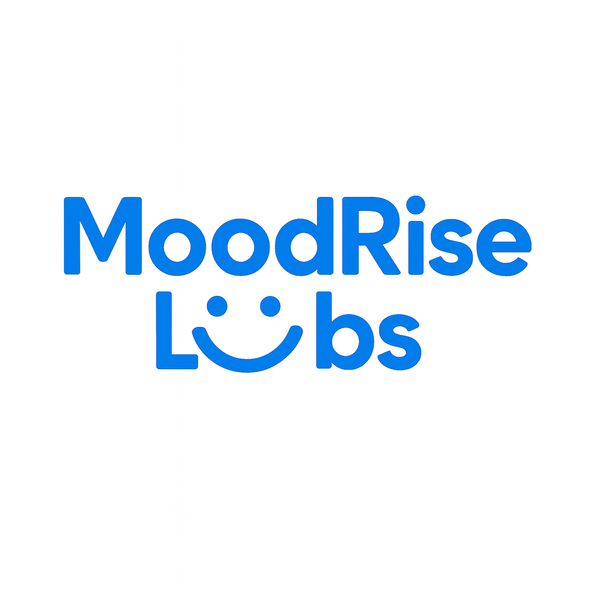Why Do We Procrastinate? The Role of Dopamine and Supplements That Support It
Introduction
Everyone has experienced it: that moment when you know exactly what needs to be done—writing an email, finishing a report, cleaning your room—but you just… don’t. You scroll through your phone, grab a snack, or suddenly feel an overwhelming need to reorganize your desk. Hours pass, and frustration builds. You’re not lazy—you’re caught in the web of procrastination.
But what if procrastination isn’t a moral failure or a lack of discipline? What if it’s a neurochemical imbalance, particularly involving the brain’s reward and motivation system—dopamine?
Recent research suggests that procrastination is deeply connected to how our brains process anticipation, effort, and reward. When dopamine—the neurotransmitter responsible for motivation and pleasure—is out of balance, even simple tasks can feel impossible to start.
In this in-depth article, we’ll unpack the science of procrastination, explore how dopamine shapes motivation, and discuss natural supplements and lifestyle strategies that can help restore balance and reignite drive.
Looking for supplements for This? Click here.
Understanding Procrastination: It’s Not Laziness, It’s Avoidance 🕒
At its core, procrastination is not about avoiding work—it’s about avoiding unpleasant emotions.
When faced with a task that feels overwhelming, boring, or uncertain, the brain’s limbic system (the emotional center) generates stress or anxiety. The prefrontal cortex, responsible for planning and decision-making, tries to push you to act—but if dopamine is low or stress is high, it loses the internal battle.
The result? You choose temporary relief over long-term gain. This relief (like checking your phone or watching YouTube) gives a quick dopamine hit, reinforcing the habit.
Essentially, procrastination is emotional regulation gone wrong. Instead of facing discomfort, we distract ourselves.
The Dopamine Connection 🎯

Dopamine is the brain’s motivation molecule. It drives us toward goals, fuels focus, and rewards us when we make progress. It’s not just about pleasure—it’s about the anticipation of reward.
In healthy balance, dopamine helps you feel energized to start tasks and satisfied when you complete them. When it’s low, motivation drops, attention drifts, and effort feels disproportionately difficult.
This is why procrastination feels less like “not wanting to work” and more like “being unable to start.”
Dopamine imbalances can arise from:
Chronic stress or burnout
Sleep deprivation
Nutrient deficiencies (like tyrosine, magnesium, or B-vitamins)
Excess stimulation from social media or gaming (dopamine overload)
Depression or low mood
Over time, these factors desensitize dopamine receptors—meaning you need more stimulation to feel motivated, and regular tasks no longer provide enough reward to trigger action.
The Neuroscience of Motivation 🧬
To understand procrastination, it helps to see how dopamine functions within the brain’s motivation loop.
The Anticipation Phase: When you think about doing something rewarding, dopamine levels rise. This motivates you to act.
The Action Phase: As you work toward the goal, dopamine keeps you engaged.
The Reward Phase: Completing the task releases dopamine again, reinforcing the behavior.
When this cycle is disrupted—say, you feel no motivation before starting or no satisfaction afterward—the drive to act diminishes.
In procrastinators, this anticipation-response loop is often underactive. They may understand what needs to be done intellectually but lack the emotional “pull” to do it.
This isn’t weakness—it’s a neurochemical feedback issue.
The Emotional Side: Fear and Avoidance 😣
Dopamine doesn’t work alone. It interacts with the amygdala, which processes fear and threat. When a task feels uncertain or potentially disappointing (“What if I fail?”), the amygdala signals danger, suppressing dopamine-driven motivation.
This creates a biological tug-of-war:
The prefrontal cortex says “Get it done.”
The amygdala says “Avoid it—it’s stressful.”
The dopamine system checks out, leaving you in emotional limbo.
The result? You feel anxious and guilty but still can’t start.
Understanding this dynamic allows us to approach procrastination with compassion—and strategy.
Dopamine Deficiency: When the Drive Dies Down 🧠💤
Low dopamine doesn’t always mean you feel sad—it often feels like apathy, low energy, or lack of momentum.
Common signs of low dopamine include:
Chronic procrastination or lack of follow-through
Difficulty focusing
Low motivation despite knowing what needs to be done
Fatigue or “flat” mood
Cravings for sugar, caffeine, or stimulation
Trouble experiencing pleasure (anhedonia)
When dopamine is depleted, even simple tasks feel like climbing a mountain.
Fortunately, lifestyle changes and specific supplements can restore dopamine signaling, helping you feel more naturally motivated.
Supplements That Support Dopamine and Motivation 🌿💊
While no supplement replaces good sleep, nutrition, and mental health care, certain nutrients and compounds can support healthy dopamine production, receptor sensitivity, and energy metabolism.
Below are some evidence-based options for supporting dopamine balance naturally.
L-Tyrosine: The Raw Material for Dopamine
What it is:
L-Tyrosine is an amino acid that serves as a precursor to dopamine (and norepinephrine). Without enough tyrosine, your brain can’t make dopamine efficiently.
Why it helps:
When you’re under chronic stress or mental fatigue, your body uses up tyrosine faster than it can replenish it. Supplementing L-Tyrosine helps restore this building block and supports alertness and focus.
Typical dose:
500–1,500 mg in the morning or before mentally demanding tasks.
Pro tip:
Combine with B6, B9, and B12, which help convert tyrosine into dopamine.
N-Acetyl L-Tyrosine (NALT): A More Bioavailable Form
NALT is a modified form of tyrosine that’s more soluble and better absorbed, especially under stress. It enhances dopamine and norepinephrine synthesis, supporting motivation and cognitive clarity.
Best for:
People who feel mentally “stuck” or fatigued by overthinking.
Typical dose: 300–600 mg daily.
Mucuna Pruriens (L-DOPA Source) 🌿
What it is:
An adaptogenic herb containing L-DOPA, the direct precursor to dopamine.
Why it helps:
Mucuna bypasses the rate-limiting step of dopamine production, giving the brain a quick supply of dopamine substrate. It also contains natural antioxidants that protect dopamine neurons.
Benefits:
Increases motivation and focus
Elevates mood and resilience
Reduces feelings of stagnation
Typical dose:
200–500 mg standardized extract (15% L-DOPA).
⚠️ Note: Avoid excessive use or stacking with antidepressants without medical guidance.
Looking for supplements for This? Click here.
Rhodiola Rosea: The Anti-Burnout Adaptogen
What it is:
A Scandinavian adaptogen that balances stress hormones and increases dopamine and serotonin sensitivity.
Why it helps:
Rhodiola boosts mental endurance and reduces fatigue caused by prolonged stress. It also protects dopamine neurons from oxidative stress.
Benefits:
Combats procrastination linked to fatigue
Improves mental energy and stress tolerance
Enhances “reward sensitivity”
Typical dose:
200–400 mg daily (standardized to 3% rosavins, 1% salidroside).
Acetyl-L-Carnitine (ALCAR): Brain Energy Support ⚡
What it is:
An amino acid that helps transport fatty acids into mitochondria for energy and supports acetylcholine and dopamine production.
Why it helps:
Low mental energy often leads to procrastination. ALCAR boosts mitochondrial efficiency, leading to sharper focus and sustained drive.
Benefits:
Supports dopamine receptor function
Increases alertness and motivation
Combats brain fog
Typical dose:
500–1,000 mg daily, morning or midday.
Omega-3 Fatty Acids: Fuel for Dopamine Neurons 🐟
What they are:
Essential fatty acids (EPA and DHA) that build neuronal membranes and modulate neurotransmitter release.
Why they help:
Omega-3s improve dopamine receptor density and flexibility in neuronal signaling—essential for consistent motivation and emotional regulation.
Benefits:
Enhances dopamine sensitivity
Reduces impulsivity and procrastination
Stabilizes mood
Typical dose:
1,000–2,000 mg combined EPA/DHA daily.
Magnesium: The Calm-Productivity Mineral 🌙
What it is:
A vital mineral that regulates over 300 enzymatic reactions, including those involved in dopamine and serotonin balance.
Why it helps:
Chronic stress depletes magnesium, leading to irritability, fatigue, and poor focus. Restoring it calms the nervous system and supports balanced dopamine release.
Typical dose:
200–400 mg magnesium glycinate or threonate daily (preferably at night).
Vitamin B-Complex: Dopamine’s Co-Factors
Why it helps:
B-vitamins (especially B6, B9, and B12) act as enzymatic co-factors in dopamine synthesis and energy metabolism. Deficiencies blunt motivation and increase anxiety.
Benefits:
Boosts neurotransmitter balance
Improves mood and concentration
Reduces fatigue
Typical dose:
A daily B-complex or multivitamin containing at least 10–25 mg of each major B vitamin.
CoQ10: Energy for Dopamine Production ⚡
What it is:
A mitochondrial nutrient that enhances cellular energy (ATP) and antioxidant protection.
Why it helps:
Dopamine synthesis requires significant energy. CoQ10 supports brain metabolism and protects neurons from oxidative damage linked to stress and burnout.
Typical dose:
100–200 mg daily with meals.
Green Tea (L-Theanine + Caffeine Combo) 🍵
Why it helps:
L-Theanine increases alpha brain waves, promoting focus and calm, while caffeine boosts alertness through mild dopamine stimulation. Together, they enhance productivity without the crash.
Benefits:
Smooth, sustained mental energy
Reduced anxiety while staying alert
Easier focus for long tasks
Typical dose:
A cup or two of green tea daily, or 100–200 mg L-theanine + 50–100 mg caffeine in supplement form.
Lifestyle Strategies for Dopamine Balance 🧘
Reduce Dopamine Overload from Technology 📱
Constant scrolling floods your brain with dopamine spikes from novelty and reward. Over time, this desensitizes receptors—making real-world tasks feel dull.
Try:
Set specific “dopamine detox” times (no social media before noon).
Replace instant-gratification habits with slower rewards like journaling or walks.
Supplements are most effective when combined with habits that naturally regulate dopamine levels.
Use the “Two-Minute Rule”
Start tasks by doing them for just two minutes. Once dopamine rises from initial engagement, motivation often follows.
Create Micro-Rewards 🏆
Breaking large goals into small steps increases dopamine hits with each success. Checking items off a list, tracking progress, or using visual boards all reinforce motivation loops.
Get Sunlight and Movement ☀️🏃
Physical activity increases dopamine receptor sensitivity and endorphin release. Morning sunlight helps regulate your circadian rhythm, improving mood and focus.
Tip: Just 20–30 minutes of brisk walking or stretching can reset your brain’s motivation system.
Prioritize Sleep 🌙
Dopamine levels reset during deep sleep. Chronic sleep deprivation lowers receptor sensitivity and increases procrastination.
Aim for 7–9 hours nightly, keeping bedtime consistent.
Meditate for Dopamine Regulation 🧘
Mindfulness increases baseline dopamine while reducing stress hormones. It also improves prefrontal cortex control over impulses and emotional reactivity.
Start with 10 minutes daily, focusing on breath awareness or guided meditations for motivation.
Eat for Brain Chemistry 🍎
A dopamine-supportive diet includes:
Protein-rich foods: Eggs, fish, chicken, tofu (for tyrosine).
Antioxidant-rich produce: Blueberries, spinach, green tea.
Healthy fats: Olive oil, avocado, nuts.
Avoid high-sugar or ultra-processed foods that spike dopamine artificially, leading to crashes.
Dopamine and the Emotional Roots of Procrastination 💭
While biology plays a huge role, procrastination is also tied to emotion and self-worth.
Many people procrastinate not because they don’t care—but because they care too much. Perfectionism, fear of failure, or self-criticism paralyze action.
Low dopamine amplifies this paralysis by making effort feel unrewarding. When the emotional brain expects disappointment, it avoids trying altogether.
To break this pattern:
Focus on effort, not outcome. Reward yourself for starting, not finishing.
Reduce emotional load. Pair difficult tasks with relaxing rituals—music, tea, deep breathing.
Reframe discomfort. Recognize procrastination as a stress response, not laziness.
Build trust with yourself. Each small completion retrains your brain to expect satisfaction, rebuilding dopamine confidence.
When to Seek Professional Help ⚕️
If you experience persistent lack of motivation, fatigue, or procrastination alongside low mood, consider consulting a healthcare professional. Conditions like ADHD, depression, or dopamine dysregulation disorders may require specialized care.
Functional medicine practitioners can also test nutrient levels (B-vitamins, magnesium, tyrosine) to tailor supplementation safely.
Looking for online therapy ? Click Here.
The Bigger Picture: Rebuilding Motivation as a Practice 🌿
Procrastination is not a flaw—it’s a feedback signal from your brain. It’s telling you something: that your dopamine, energy, or self-compassion reserves need attention.
By supporting your dopamine system nutritionally and emotionally, you can rebuild consistent motivation without relying on guilt or pressure.
Healing procrastination is about restoring balance, not forcing productivity.
Key Takeaways 🧠
Procrastination stems from low dopamine, fear, and emotional overload.
Dopamine drives anticipation, focus, and reward—imbalances cause inertia.
Supplements like L-Tyrosine, Rhodiola, Omega-3s, and B-complex vitamins can restore motivation.
Healthy habits—sleep, sunlight, movement, and mindfulness—naturally balance dopamine.
Motivation grows from safety and self-compassion, not self-criticism.
When your dopamine system is nourished and calm, starting feels natural—and progress becomes satisfying again.
Because the goal isn’t to force productivity—it’s to fall back in love with forward motion. 🌿✨
References 📚
Salamone, J. D., & Correa, M. (2012). The mysterious motivational functions of mesolimbic dopamine. Neuron.
Volkow, N. D., et al. (2011). Dopamine and the brain’s reward circuitry in motivation and addiction. American Journal of Psychiatry.
McGuire, J. T., & Kable, J. W. (2013). Dopamine, delay discounting, and the neurobiology of procrastination. Journal of Neuroscience.
Arnsten, A. F. T. (2009). Stress signaling pathways that impair prefrontal cortex structure and function. Nature Reviews Neuroscience.
Benton, D., & Donohoe, R. (1999). The influence of tyrosine on cognitive performance and stress resilience. Brain Research Bulletin.
Panossian, A., & Wikman, G. (2010). Rhodiola rosea and adaptogenic regulation of stress response. Phytomedicine.
Wurtman, R. J., & Cansev, M. (2011). Nutritional support for neurotransmitter synthesis and mental performance. Nature Reviews Neuroscience.
Jang, Y., et al. (2018). Dopamine receptor sensitivity and behavioral motivation. Frontiers in Psychology.
Kennedy, D. O. (2016). Nutritional influences on cognitive function and motivation. Nutrition Reviews.
Peirson, S. N., & Foster, R. G. (2014). Sleep and dopamine regulation in cognition and emotion. Trends in Neurosciences.
Related Posts
-
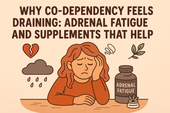
Why Co-Dependency Feels Draining: Adrenal Fatigue and Supplements That Help
The adrenal glands are small but powerful organs that sit above your kidneys, acting as your body’s built-in stress managers. They produce hormones like cortisol and adrenaline that help regulate energy, mood, and resilience. When they’re overworked from chronic stress or emotional exhaustion, fatigue and imbalance follow. Supporting adrenal health naturally can help restore calm, energy, and hormonal balance. 🌿⚡
-

The Link Between Anxiety, Co-Dependency, and Natural Support
Anxiety feels like living in constant alert mode—your heart races, your thoughts loop, and your body can’t find peace. It’s the nervous system’s way of preparing for danger, even when none exists. Understanding what’s happening in your mind and body is the first step toward calming the storm and restoring balance. 🌿💫
-
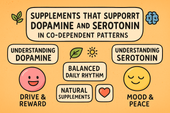
Supplements That Support Dopamine and Serotonin in Co-Dependent Patterns
Serotonin is the neurotransmitter of calm, confidence, and contentment. When it’s balanced, you feel peaceful and emotionally grounded. When it’s low, anxiety, mood swings, and emotional dependence take over. By understanding serotonin’s role in emotional health—and how to support it naturally—you can rebuild inner stability, improve relationships, and cultivate lasting happiness from within. 🌞💫
-

How Emotional Exhaustion in Codependency Impacts the Nervous System
The nervous system is the body’s communication network, connecting the brain to every organ and muscle. It regulates stress, mood, and emotion through a delicate balance of electrical and chemical signals. When overwhelmed, it can become dysregulated—leading to fatigue, anxiety, and emotional imbalance. Understanding how to calm and strengthen the nervous system is key to healing from chronic stress and emotional burnout. ⚡🌿
-
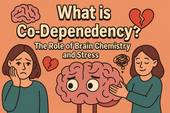
What Is Co-Dependency? The Role of Brain Chemistry and Stress
Stress is more than a feeling—it’s a full-body experience that begins in the brain and ripples through every cell. When cortisol surges and the nervous system stays on alert, your body can’t rest or recover. Over time, this constant tension affects energy, focus, mood, and even immune health. Understanding stress chemistry is the first step toward breaking free from burnout and finding calm again. 🌿
-

Creating a Supplement Stack for Motivation, Energy, and Anti-Procrastination
Motivation is the fuel behind every meaningful achievement—but it’s not just about willpower. It’s a mix of mindset, brain chemistry, and momentum. When energy, focus, and purpose align, action feels natural instead of forced. Learn how to harness motivation as a daily state, not a fleeting feeling.
-
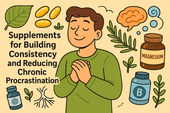
Supplements for Building Consistency and Reducing Chronic Procrastination
Biochemistry is the bridge between biology and chemistry—the science of life at the molecular level. It explains how nutrients, hormones, and neurotransmitters interact to create energy, thought, and emotion. From brain function to muscle movement, biochemistry reveals the invisible processes that sustain health, balance, and vitality.
-
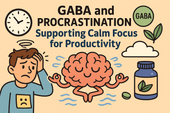
GABA and Procrastination: Supporting Calm Focus for Productivity
GABA is the brain’s natural calming messenger—a neurotransmitter that helps slow mental overactivity and ease stress. When GABA levels drop, focus fades, anxiety rises, and procrastination becomes more likely. By supporting GABA through nutrition, lifestyle, and supplements, you can restore calm clarity, improve focus, and take action with steady, balanced energy.
-
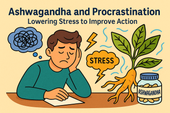
Ashwagandha and Procrastination: Lowering Stress to Improve Action
Science is the language of curiosity and discovery. It helps us understand the hidden patterns behind life, energy, and the universe. Through experimentation and critical thinking, science connects imagination to evidence—turning questions into knowledge. Whether through microscopes, molecules, or minds at work, science represents our endless pursuit of truth and innovation.
-

Neurotransmitters and Motivation: Supplements That Support Drive and Focus
Supplements can do more than boost physical health—they can also enhance mental clarity, focus, and motivation. Nutrients like omega-3s, magnesium, B vitamins, and adaptogens help balance neurotransmitters, stabilize mood, and support brain energy. When combined with good sleep, nutrition, and mindful habits, they can transform how your brain performs under stress.
-

How Stress Hormones Like Cortisol Fuel Procrastination (and What Helps)
Blood sugar isn’t just about physical health—it directly impacts focus, mood, and motivation. When glucose levels spike and crash, energy and attention do the same, fueling procrastination and brain fog. Learning how to stabilize blood sugar through balanced meals, mindful habits, and key nutrients helps keep your mind steady, focused, and ready to act.
-
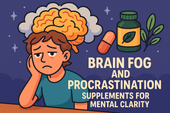
Brain Fog and Procrastination: Supplements for Mental Clarity
Brain fog can turn even simple tasks into mental hurdles. When your thoughts feel slow and unclear, procrastination often follows—making focus and productivity seem impossible. This article explores the biochemical and lifestyle causes of brain fog and reveals the most effective supplements for restoring mental clarity, focus, and sustained energy.
-

The Link Between Low Energy and Procrastination: Can Supplements Help?
Neurochemistry shapes how we think, feel, and act. When neurotransmitters like dopamine, serotonin, and GABA fall out of balance, it can lead to fatigue, anxiety, or lack of motivation—fueling procrastination and low mood. Understanding the brain’s chemical communication system helps us find ways to restore focus, calm, and emotional stability through nutrition, mindfulness, and targeted supplements.
-
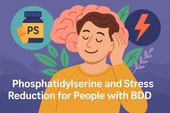
Phosphatidylserine and Stress Reduction for People with BDD
Stress is more than a mental state—it’s a full-body experience that affects hormones, brain chemistry, and emotional balance. For people with Body Dysmorphic Disorder (BDD), constant tension and worry about appearance can overload the nervous system. Learning how stress works and finding ways to calm it is key to breaking the cycle of anxiety and self-criticism.
-

How Antioxidants Like Vitamin C & E Support Mental Health in BDD
Antioxidants are the body’s natural defense against stress and inflammation. For people with Body Dysmorphic Disorder (BDD), oxidative stress can worsen fatigue, anxiety, and emotional imbalance. Nutrients like Vitamin C and E help protect brain cells, boost neurotransmitter function, and support a calmer, clearer mindset—building a stronger foundation for recovery.
-
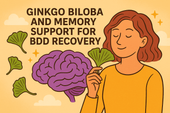
Ginkgo Biloba and Memory Support for BDD Recovery
Emotional regulation is the foundation of healing from Body Dysmorphic Disorder (BDD). When the nervous system stays in constant overdrive, even small stressors can trigger self-critical spirals. Learning to calm emotional reactivity helps restore clarity, confidence, and a sense of inner balance. By blending mindfulness, nervous system support, and self-compassion, you can retrain your brain to respond—not react—to emotion.
-
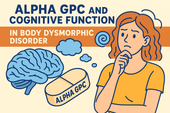
Alpha GPC and Cognitive Function in Body Dysmorphic Disorder
Mental fatigue can feel like your brain has hit a wall—thoughts slow down, focus fades, and motivation disappears. For people with Body Dysmorphic Disorder (BDD), chronic overthinking, emotional stress, and constant self-evaluation can deplete mental energy even further. Understanding what causes this cognitive exhaustion is the first step toward recovery—through rest, balanced nutrition, and targeted brain-supporting supplements.
-
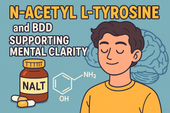
N-Acetyl L-Tyrosine and BDD: Supporting Mental Clarity
Chronic stress doesn’t just affect your mood—it reshapes your brain chemistry, weakens focus, and fuels the obsessive thought loops common in Body Dysmorphic Disorder (BDD). Over time, constant cortisol elevation drains mental energy and emotional balance. Learning to recognize and manage chronic stress is essential to restoring mental clarity, self-compassion, and resilience.
-

Chamomile and Lavender for Calming Obsessive Body Image Thoughts
The nervous system is the command center of our emotional and physical world—and in Body Dysmorphic Disorder (BDD), it often operates in overdrive. Understanding how the brain and body communicate under stress reveals why intrusive thoughts feel uncontrollable. Learning to regulate the nervous system through calm practices, nutrition, and supplements helps restore inner balance and emotional safety.
-
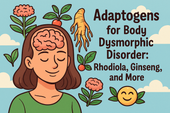
Adaptogens for Body Dysmorphic Disorder: Rhodiola, Ginseng, and More
Rhodiola rosea, often called the “golden root,” is an adaptogenic herb renowned for boosting stress resilience and mental endurance. For individuals with Body Dysmorphic Disorder (BDD), Rhodiola may help reduce fatigue, regulate cortisol, and enhance emotional balance. By supporting both mind and body, this powerful plant promotes calm focus, improved mood, and renewed energy to face daily challenges.
-
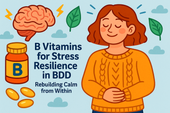
B Vitamins for Stress Resilience in BDD: Rebuilding Calm from Within
Biochemistry is at the heart of every thought, emotion, and reaction we experience. In Body Dysmorphic Disorder (BDD), chemical imbalances in neurotransmitters like serotonin, dopamine, and GABA can amplify stress and distort self-perception. Understanding the biochemistry behind mood and stress regulation offers a path toward healing—bridging the gap between emotional experience and the body’s molecular balance.
-
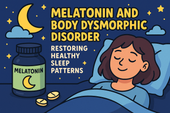
Melatonin and Body Dysmorphic Disorder: Restoring Healthy Sleep Patterns
Melatonin, the body’s natural sleep hormone, plays a vital role in helping people with Body Dysmorphic Disorder (BDD) restore healthy sleep cycles. When anxiety and obsessive thinking interfere with rest, melatonin levels often drop, leading to more emotional reactivity and distorted self-perception. This article explores how melatonin works, why BDD disrupts it, and how natural supplementation—combined with mindful routines—can help the brain and body finally find calm at night.
-
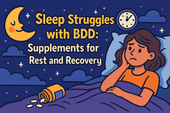
Sleep Struggles with BDD: Supplements for Rest and Recovery
When you’re living with Body Dysmorphic Disorder (BDD), restful sleep can feel impossible—but the right supplements can help reset your body’s natural rhythm. From magnesium and L-theanine to 5-HTP and ashwagandha, these nutrients support relaxation, lower cortisol, and enhance melatonin production. This article explores how supplements can calm the mind, ease nighttime anxiety, and promote true restorative sleep for emotional and physical recovery.
-
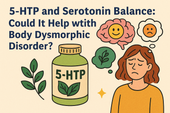
5-HTP and Serotonin Balance: Could It Help with Body Dysmorphic Disorder?
Anxiety can feel like a storm inside the mind—restless, overwhelming, and hard to control. In people with Body Dysmorphic Disorder (BDD), anxiety often fuels obsessive thoughts and self-criticism, creating a painful cycle of worry and self-doubt. This article explores the biological roots of anxiety, the role of neurotransmitters like serotonin and GABA, and how natural strategies such as mindfulness, supplements, and nervous system regulation can restore calm and mental clarity.
-
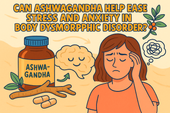
Can Ashwagandha Help Ease Stress and Anxiety in Body Dysmorphic Disorder?
Neurotransmitters like serotonin, dopamine, GABA, and acetylcholine are the chemical messengers that shape how we think, feel, and react to stress. In Body Dysmorphic Disorder (BDD), imbalances in these neurotransmitters can amplify anxiety, obsessive thinking, and emotional distress. This article explores how restoring healthy brain chemistry through nutrition, supplements, and mindfulness can help bring clarity, calm, and emotional stability.
-
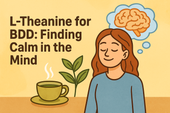
L-Theanine for BDD: Finding Calm in the Mind
Neurochemistry plays a central role in how we think, feel, and see ourselves. For those living with Body Dysmorphic Disorder (BDD), imbalances in neurotransmitters like serotonin, dopamine, and GABA can intensify anxiety, obsessive thoughts, and emotional distress. This article explores how regulating brain chemistry through supplements, mindfulness, and lifestyle changes can bring the nervous system back into harmony and restore inner calm.
-

Omega-3 Fatty Acids and Body Image Disorders: Supporting Emotional Health
Omega-3 fatty acids do far more than support heart health—they nourish the brain, stabilize mood, and may ease the emotional turbulence tied to body image disorders like BDD. This in-depth article explores how omega-3s regulate serotonin, dopamine, and inflammation, helping individuals reduce obsessive thoughts and rebuild self-acceptance. It also connects nutrition to therapy, mindfulness, and nervous system balance for holistic emotional healing.
-
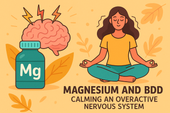
Magnesium and BDD: Calming an Overactive Nervous System
Magnesium plays a crucial role in calming an overactive nervous system—something people with Body Dysmorphic Disorder (BDD) struggle with daily. This article explores how magnesium supports relaxation, emotional regulation, and stress reduction while diving into the science behind its connection to brain chemistry. It also examines how combining magnesium supplementation with therapy and breathwork can help rebalance the body’s stress response, reduce obsessive thought patterns, and promote lasting nervous system calm.
-
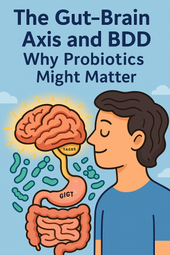
The Gut-Brain Axis and BDD: Why Probiotics Might Matter
The gut and brain are constantly in conversation — and that dialogue may shape how you experience Body Dysmorphic Disorder. By nurturing your microbiome with probiotics, prebiotics, and gut-healing nutrients, you can help rebalance serotonin, calm anxiety, and restore emotional stability from within 🧠🦠.
-
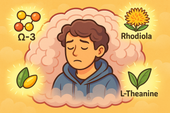
Brain Fog and Body Dysmorphic Disorder: Can Nootropic Supplements Help?
Brain fog often accompanies Body Dysmorphic Disorder, clouding focus and deepening emotional fatigue. Nootropic supplements like L-theanine, Rhodiola, and CoQ10 can help restore mental clarity, balance neurotransmitters, and bring calm energy back to the mind 🌿🧠.
-
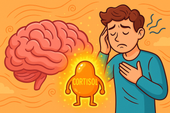
How Stress Hormones Like Cortisol May Worsen Body Dysmorphic Disorder
Chronic stress floods the brain with cortisol — the hormone that keeps you on high alert. In Body Dysmorphic Disorder, this chemical overdrive fuels anxiety, distorts self-image, and traps the body in survival mode. Calming cortisol helps restore both peace and perspective 🌿🧠.
-
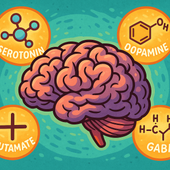
The Role of Neurotransmitters in BDD—and How Supplements May Help
Neurotransmitters like serotonin, dopamine, glutamate, and GABA shape how people with Body Dysmorphic Disorder perceive themselves. When these brain messengers fall out of balance, perception distorts — but targeted supplements can help restore calm, focus, and emotional regulation 🧠🌿.
-

What Is Body Dysmorphic Disorder? A Deeper Look at the Mind-Body Connection
Body Dysmorphic Disorder (BDD) isn’t just about appearance — it’s about perception. When brain chemistry, trauma, and stress distort self-image, the mind begins to see flaws that aren’t truly there. Healing starts by calming the nervous system and reconnecting mind and body 🪞🧠.
-
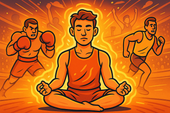
Keeping Calm in Competitive Sports: How to Train Your Mind, Body, and Chemistry for Peak Performance
Competitive pressure can overwhelm even the strongest athletes — but calm is trainable. By combining supplements like magnesium, L-theanine, and adaptogens with breathwork and mindset training, you can stay focused, balanced, and in control under any level of stress 🧠🏅.
-
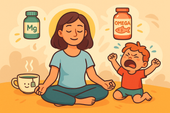
Supplements for Parents Facing Toddler Tantrums: Staying Calm When Little Emotions Run Wild
Toddler tantrums can drain even the most loving parent — but your calm is powerful. With the right supplements like magnesium, L-theanine, and ashwagandha supporting your nervous system, you can stay patient, grounded, and kind, even when emotions run high 🧸🌿.
-

Workplace Stress and Anger Management Support
Workplace stress can quickly turn into frustration — but calm is a skill you can train. By combining supplements like magnesium, L-theanine, and adaptogens with breathwork and mindset tools, you can stay focused, patient, and emotionally grounded no matter how intense the office gets 💼🌿.
-

How to Stay Patient With Family During Stressful Holidays
Holiday gatherings can stir up old stress and test your patience — but calm is possible. With nervous system support from magnesium, L-theanine, and adaptogens, plus mindful breathing and clear boundaries, you can stay centered, kind, and grounded even when family chaos unfolds 🎄💞.
-
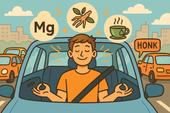
Supplements to Keep Calm During Traffic Jams
Getting stuck in traffic doesn’t have to ruin your mood. With calming supplements like magnesium, L-theanine, and ashwagandha, you can train your body to stay relaxed and focused behind the wheel — turning gridlock into a moment of grounded patience 🚗🌿.
-
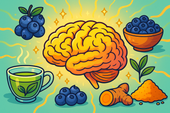
The Role of Antioxidants in Healing Brain Stress from Dissociation
Antioxidants protect the brain from the oxidative stress caused by trauma and dissociation. By neutralizing free radicals and supporting mitochondrial recovery, they help restore clarity, focus, and emotional balance — allowing the mind to heal at the cellular level 🌿🧠.
-
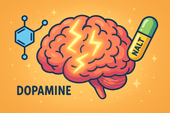
N-Acetyl L-Tyrosine (NALT) for Supporting Mental Clarity
N-Acetyl L-Tyrosine (NALT) fuels dopamine production — the neurotransmitter of focus and motivation. By supporting brain chemistry during stress, NALT helps restore mental clarity, energy, and alertness, making it easier to think clearly and feel present again ⚡🧠.
-

How Ginseng May Improve Focus and Energy in Dissociation
Ginseng helps combat the mental fatigue and fog that often come with dissociation. By supporting mitochondrial energy, balancing neurotransmitters, and regulating cortisol, it gently restores focus, motivation, and emotional presence — helping the mind reconnect with clarity and strength 🌿⚡.
-
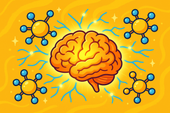
Phosphatidylserine and Dissociation: Supporting Cognitive Function
Phosphatidylserine helps calm the stress response by balancing cortisol, the body’s primary stress hormone. By lowering cortisol spikes, it protects memory, focus, and emotional stability — restoring clarity and mental presence for those struggling with dissociation 🧠🌿.
-
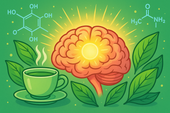
Can Green Tea Extract Help with Dissociative Brain Fog?
Green tea extract may help lift dissociative brain fog by supporting neurotransmitter balance, reducing inflammation, and enhancing energy at the cellular level. With its key compounds EGCG and L-theanine, it promotes calm focus, clarity, and emotional presence — helping you feel more alert and grounded 🍵🧠.
-
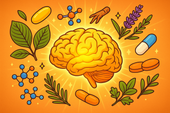
Building a Natural Supplement Stack for Dissociation Support
Building a supplement stack for dissociation means nourishing the brain and body back into communication. By supporting neurotransmitters, gut health, and energy balance through nutrients like magnesium, omega-3s, curcumin, and probiotics, you can help restore clarity, calm, and connection — one layer at a time 🌿🧠.
-

Chamomile and Lavender for Dissociative Anxiety Relief
Chamomile and lavender work together to calm dissociative anxiety by soothing the nervous system and restoring emotional safety. Their natural compounds balance cortisol, enhance GABA activity, and activate the vagus nerve — helping you feel grounded, connected, and at peace again 🌿💜.
-
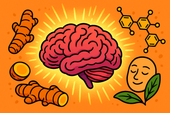
Curcumin for Inflammation and Mental Clarity in Dissociation
Curcumin, the golden compound in turmeric, does more than fight inflammation — it helps clear the mental fog often tied to dissociation. By calming neuroinflammation, balancing neurotransmitters, and supporting mitochondrial energy, curcumin can restore mental clarity, focus, and emotional presence 🌿🧠.
-
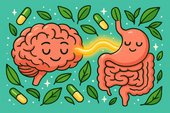
Probiotics and Dissociation: Exploring the Gut–Brain Axis
The gut–brain axis plays a vital role in emotional awareness and presence. When the microbiome is balanced, it supports serotonin production, vagus nerve activity, and calm focus. Probiotics help repair this connection — restoring safety, clarity, and the feeling of truly being in your body again 🌿🧠.
-
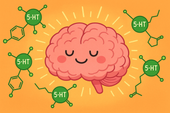
5-HTP for Dissociation: Supporting Serotonin and Emotional Stability
5-HTP helps bridge the gap between emotional numbness and stability by supporting serotonin production — the neurotransmitter that shapes mood, sleep, and sensory awareness. For people experiencing dissociation, 5-HTP may gently restore connection, presence, and emotional balance from the inside out 🌿🧠.
-
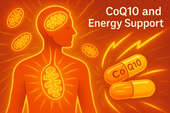
CoQ10 and Energy Support for People with Dissociation
Chronic dissociation often leaves the body running on empty — tired, foggy, and disconnected. CoQ10 helps recharge that system at the cellular level by restoring mitochondrial energy, reducing oxidative stress, and supporting the brain’s capacity to stay present. It’s energy medicine for both body and mind ⚡🧠.
